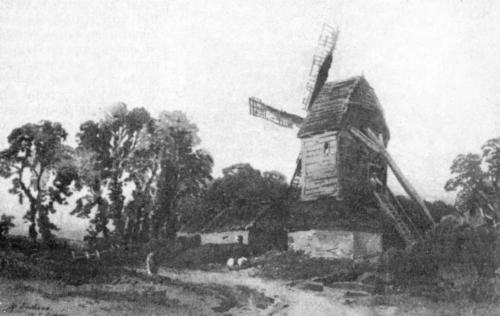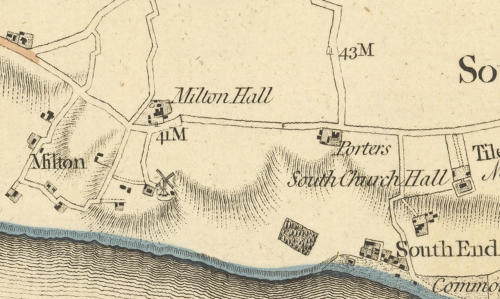Hamlet Mill
Hamlet
Mill
(also
called
the
Milton
Mill)
was
a
post
mill
that
stood
on
the
south
side
of
Avenue
Road
by
the
junction
with
Park
Road
(opposite
the
methodist
church).
It
was
in
the
area
known
as
Milton
being
on
the
Milton
Hall
(now
Nazareth
House)
Estate
that
belonged
to
the
Scratton
Family. Hamlet Mill is also called the Milton Mill.
The
mill
also
served
the
area
known
as
the
Hamlet
(now
Station
Road,
Westcliff)
before
that
area
was
cut
in
two
by
the
railway
line
and
so
it
was
called
the
Hamlet
Mill.
The
mill
gives
its
name
to
Hamlet
Road
on
the
north
side
of
the
railway.
The
mill
can
be
traced
back
to
at
least
1299
when
a
"new mill" was built on the site for £15 5s. 10d.
The
mill
was
involved
in
a
turbulent
period
of
English
history
following
the
reign
of
Richard
II
(1367-1400).
Richard
had
been
deposed
and
imprisoned
by
his
cousin
Henry
Bolingbroke
in
1399
whereupon
Henry
was
crowned
Henry
IV
at
Westminster
Abbey.
Richard
later
died
in
mysterious
circumstances
while
imprisoned.
This
event
would
later
form
the
basis
of
the
Wars
of
the
Roses
(or
'cousins
war'
as
it
was
called
at
the
time.
The
Duke
of
Exeter,
a
half
brother
of
Richard
II,
was
involved
in
an
unsuccessful
plot
against
the
new
King,
Henry,
and
tried
to
escape
the
country.
He
fled
to
Essex
and
took
a
ship
to
the
Continent
but
was
driven
back
by
strong
winds.
He
was
then
captured
at
Hamlet
Mill
where
he
had
sought
refuge
and
was
said
to
have
been
dining
with
John
of
Prittlewell.
The
villagers
took
him
to
Pleshey
Castle
(near
Chelmsford).
At
Pleshey,
the
late
Duke
of
Gloucester's
mother-in
law
had
him
beheaded.
It
was
Exeter
who
had
seized
and
murdered
Gloucester
on
Richard's
orders
and
the
mother-in-law
took
her
revenge
fearing
that
Henry
might
be
persuaded
to
spare
him
otherwise.
Her
servants
are
said
to
have
tortured
and
torn his body with barbarous cruelty before his execution.
To
north
of
the
mill
was
an
open
space
(with
a
pond)
where
cricket
was
played
in
the
19th
century
(hence
the
names
of
Park
Road
and
the
Cricketers
pub).
Records
show
that
the
mill
was
being
occupied
in
1848
by
Lazarus
and
Company
who
would
have
been
leasing
the
property
from
the
landowner,
Daniel
Robert
Scratton.
Scratton's
sale
of
land
in
1869
was
a
key
event
in
the
town's
history.
He
was
then
retiring
as
Lord
of
The
Manor
and
moving
to
Devon
after
the
coming
of
the
railway
line
in
1856.
Much
of
the
land
between Hamlet Court Road and the High Street was sold to Thomas Dowsett in the sale.
Scratton
had
been
a
popular
figure
who
did
much
that
was
in
the
town
and
its
people's
best
interest.
However,
the
one
act
for
which
he
did
receive
some
local
criticism
was
the
sale
of
the
land
where
Hamlet
Mill
was
situated
(as
part
of
the
1869
sale).
The
mill
had
been a popular landmark and locals were annoyed when it was subsequently demolished as a result of the sale.
In
1874,
Thomas
Arnold
was
in
occupation
at
the
mill,
presumably
as
a
sitting
tenant
for
the
duration
of
his
lease.
In
1875,
Thomas
Dowsett
and
his
partner
John
George
Baxter
(a
fish
merchant
and
co-owner
of
Luker's
Brewery)
conveyed
the
whole
area
around
the
mill
to
solicitors
for
sale
as
building
plots
of
the
'Southend
Park
Estate'.
A
record
of
the
sale
describes
the
land
as
comprising
"Avenue
Road,
Park
Road,
Park
Street,
Leigh
Road
[now
London
Road],
Hamlet
Road
and
Queen's
Road".
All
but
London
Road
and
Avenue
Road
(which
had
formerly
provided
access
to
the
mill)
were
new
roads.
Thus
the
area
around
the
mill
was
sold
for
residential
development and became the housing seen today.
Hamlet
Mill
was
included
in
the
1875
sale
and
is
shown
on
the
plans.
The
mill
is
also
shown
on
the
1875
OS
map
where
it
is
labelled
as
a
corn
mill.
A
building
plan
for
alterations
to
the
adjacent
Mill
House
on
Avenue
Road
is
dated
1878
and
this
suggests
the
mill
had
been
demolished
by
that
time.
Farries'
history
of
Essex
windmills
gives
a
date
of
1877
for
the
demolition
of
the
mill.
However
Jessie
K.
Payne,
who
relied
upon
local
historians
and
sources
for
her
1985
"Southend-on-Sea,
a
Pictorial
History",
describes
the
mill
as
remaining in use until 1880 and being finally demolished in 1892.

Southend Timeline Southend-on-Sea © 2009 - 2024. All Rights Reserved



SOUTHEND CITY

Milton Mill

1777 'Map of the County of Essex' by John Chapman & Peter André

Southend-on-Sea’s No 1 History Website! Documenting The Town & The Townspeople
Now Incorporating The Sea Of Change Website
Website Info:


Chalkwell ▪ Eastwood ▪ Leigh-on-Sea ▪ Prittlewell ▪ Shoeburyness ▪ Southchurch ▪ Thorpe Bay ▪ Westcliff-on-Sea
































































